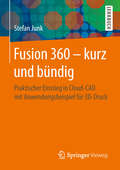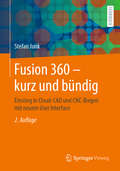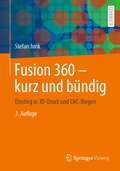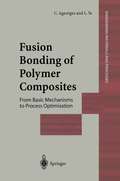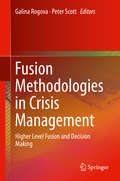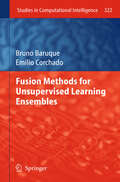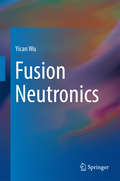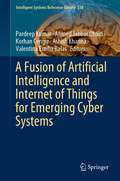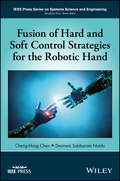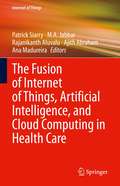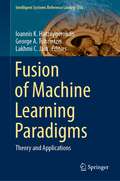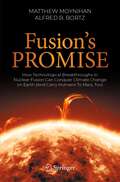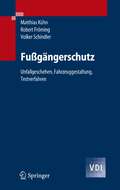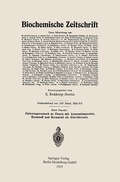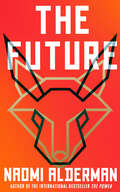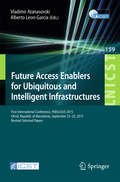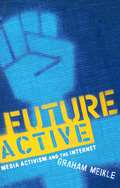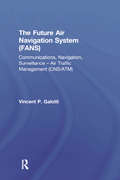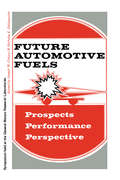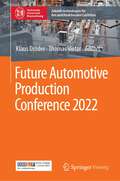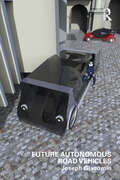- Table View
- List View
Fusion 360 – kurz und bündig: Praktischer Einstieg in Cloud-CAD mit Anwendungsbeispiel für 3D-Druck
by Stefan JunkDieses Lehrbuch ermöglicht dem Anfänger in der 3D-Modellierung einen schnellen Einstieg in die Arbeit mit dem cloudbasierten CAD-System Autodesk® Fusion 360TM. Der Schwerpunkt liegt dabei auf den grundlegenden Funktionen zur Modellierung von Einzelteilen und Produkten, sowie in der Erstellung von einfachen technischen Zeichnungen. Dabei werden bei jedem Schritt die besonderen Anforderungen an eine 3D-Druck-gerechte Gestaltung erläutert und umgesetzt. Somit ist das Ergebnis dieser „Schritt für Schritt“-Anleitung die vollständige Modellierung eines Miniatur-Automobils, das am 3D-Drucker in ein reales Modell umgesetzt werden kann. Das didaktische Konzept ist so ausgelegt, dass alle Schritte für ein Selbststudium geeignet sind.
Fusion 360 – kurz und bündig: Einstieg in Cloud-CAD und CNC-Biegen mit neuem User Interface
by Stefan JunkDieses Lehrbuch ermöglicht dem Anfänger in der 3D-Modellierung einen schnellen Einstieg in die Arbeit mit dem cloudbasierten CAD-System Autodesk® Fusion 360TM. Der Schwerpunkt liegt dabei auf den grundlegenden Funktionen zur Modellierung von Einzelteilen und dem Zusammenbau von Produkten, sowie in der Erstellung von einfachen technischen Zeichnungen. Dabei werden bei jedem Schritt die besonderen Anforderungen an eine 3D-Druck-gerechte Gestaltung erläutert und umgesetzt. Somit ist das Ergebnis dieser „Schritt für Schritt“-Anleitung die vollständige Modellierung eines Miniatur-Automobils, das am 3D-Drucker in ein reales Modell umgesetzt werden kann. Das didaktische Konzept ist so ausgelegt, dass alle Schritte für ein Selbststudium geeignet sind. Die vorliegende Auflage wurde komplett überarbeitet, sie basiert auf der neuen Benutzeroberfläche User Interface (UI) und enthält ein neues Kapitel zum CNC-Blechbiegen.
Fusion 360 – kurz und bündig: Einstieg in 3D-Druck und CNC-Biegen
by Stefan JunkDieses Lehrbuch ermöglicht dem Anfänger in der 3D-Modellierung einen schnellen Einstieg in die Arbeit mit dem cloudbasierten CAD-System Autodesk® Fusion 360TM. Der Schwerpunkt liegt dabei auf den grundlegenden Funktionen zur Modellierung von Einzelteilen und dem Zusammenbau von Produkten, sowie in der Erstellung von einfachen technischen Zeichnungen. Dabei werden bei jedem Schritt die besonderen Anforderungen an eine 3D-Druck-gerechte Gestaltung erläutert und umgesetzt. Somit ist das Ergebnis dieser „Schritt für Schritt“-Anleitung die vollständige Modellierung eines Miniatur-Automobils, das am 3D-Drucker in ein reales Modell umgesetzt werden kann. Das didaktische Konzept ist so ausgelegt, dass alle Schritte für ein Selbststudium geeignet sind. In der vorliegenden Auflage wurde die Konstruktionsmethodik überarbeitet und einige Kapitel wurden ergänzt, beispielweise um das Erstellen von Teams.
Fusion Bonding of Polymer Composites (Engineering Materials and Processes)
by C. Ageorges L. YeFusion bonding is one of the three methods available for joining composite and dissimilar materials. While the other two, mechanical fastening and adhesion bonding, have been the subject of wide coverage both in textbooks and monographs, fusion bonding is covered here substantially for the first time. Fusion bonding offers a number of advantages over traditional joining techniques and it is anticipated that its use will increase dramatically in the future because of the rise in the use of thermoplastic matrix composites and the growing necessity for recyclability of engineering assemblies. Fusion Bonding of Polymer Composites provides an in-depth understanding of the physical mechanisms involved in the fusion bonding process, covering such topics as:- heat transfer in fusion bonding;- modelling thermal degradation;- consolidation mechanisms;- crystallisation kinetics;- processing-microstructure-property relationship;- full-scale fusion bonding;- fusion bonding of thermosetting composite/thermoplastic composite and metal/thermoplastic joints.The book focuses on one practical case study using the resistance welding process. This example exposes the reader to the development of processing windows for a novel manufacturing process including the use of experimental test programmes and modelling strategies.
Fusion Methodologies in Crisis Management: Higher Level Fusion and Decision Making
by Galina Rogova Peter ScottThe book emphasizes a contemporary view on the role of higher level fusion in designing crisis management systems, and provide the formal foundations, architecture and implementation strategies required for building dynamic current and future situational pictures, challenges of, and the state of the art computational approaches to designing such processes. This book integrates recent advances in decision theory with those in fusion methodology to define an end-to-end framework for decision support in crisis management. The text discusses modern fusion and decision support methods for dealing with heterogeneous and often unreliable, low fidelity, contradictory, and redundant data and information, as well as rare, unknown, unconventional or even unimaginable critical situations. Also the book examines the role of context in situation management, cognitive aspects of decision making and situation management, approaches to domain representation, visualization, as well as the role and exploitation of the social media. The editors include examples and case studies from the field of disaster management.
Fusion Methods for Unsupervised Learning Ensembles (Studies in Computational Intelligence #322)
by Bruno BaruqueThe application of a “committee of experts” or ensemble learning to artificial neural networks that apply unsupervised learning techniques is widely considered to enhance the effectiveness of such networks greatly. This book examines the potential of the ensemble meta-algorithm by describing and testing a technique based on the combination of ensembles and statistical PCA that is able to determine the presence of outliers in high-dimensional data sets and to minimize outlier effects in the final results. Its central contribution concerns an algorithm for the ensemble fusion of topology-preserving maps, referred to as Weighted Voting Superposition (WeVoS), which has been devised to improve data exploration by 2-D visualization over multi-dimensional data sets. This generic algorithm is applied in combination with several other models taken from the family of topology preserving maps, such as the SOM, ViSOM, SIM and Max-SIM. A range of quality measures for topology preserving maps that are proposed in the literature are used to validate and compare WeVoS with other algorithms. The experimental results demonstrate that, in the majority of cases, the WeVoS algorithm outperforms earlier map-fusion methods and the simpler versions of the algorithm with which it is compared. All the algorithms are tested in different artificial data sets and in several of the most common machine-learning data sets in order to corroborate their theoretical properties. Moreover, a real-life case-study taken from the food industry demonstrates the practical benefits of their application to more complex problems.
Fusion Neutronics (Springer Tracts in Modern Physics #271)
by Yican WuThis book provides a systematic and comprehensive introduction to fusion neutronics, covering all key topics from the fundamental theories and methodologies, as well as a wide range of fusion system designs and experiments. It is the first-ever book focusing on the subject of fusion neutronics research.Compared with other nuclear devices such as fission reactors and accelerators, fusion systems are normally characterized by their complex geometry and nuclear physics, which entail new challenges for neutronics such as complicated modeling, deep penetration, low simulation efficiency, multi-physics coupling, etc. The book focuses on the neutronic characteristics of fusion systems and introduces a series of theories and methodologies that were developed to address the challenges of fusion neutronics. Further, it introduces readers to the unique principles and procedures of neutronics design, experimental methodologies and methodologies for fusion systems. The book not only highlights the latest advances and trends in the field, but also draws on the experiences and skills collected in the author’s more than 40 years of research. To make it more accessible and enhance its practical value, various representative examples are included to illustrate the application and efficiency of the methods, designs and experimental techniques discussed.
A Fusion of Artificial Intelligence and Internet of Things for Emerging Cyber Systems (Intelligent Systems Reference Library #210)
by Pardeep Kumar Ahmed Jabbar Obaid Korhan Cengiz Ashish Khanna Valentina Emilia BalasThis book aims at offering a unique collection of ideas and experiences mainly focusing on the main streams and merger of Artificial Intelligence (AI) and the Internet of Things (IoT) for a wide slice of the communication and networking community. In the era when the world is grappling with many unforeseen challenges, scientists and researchers are envisioning smart cyber systems that guarantee sustainable development for a better human life. The main contributors that destined to play a huge role in developing such systems, among others, are AI and IoT. While AI provides intelligence to machines and data by identifying patterns, developing predictions, and detecting anomalies, IoT performs as a nerve system by connecting a huge number of machines and capturing an enormous amount of data. AI-enabled IoT, therefore, redefines the way industries, businesses, and economies function with increased automation and efficiency and reduced human interaction and costs.This book is an attempt to publish innovative ideas, emerging trends, implementation experience, and use-cases pertaining to the merger of AI and IoT. The primary market of this book is centered around students, researchers, academicians, industrialists, entrepreneurs, and professionals working in electrical/computer engineering, IT, telecom/electronic engineering, and related fields. The secondary market of this book is related to individuals working in the fields such as finance, management, mathematics, physics, environment, mechatronics, and the automation industry.
Fusion of Hard and Soft Control Strategies for the Robotic Hand (IEEE Press Series on Systems Science and Engineering)
by Cheng-Hung Chen Desineni Subbaram NaiduAn in-depth review of hybrid control techniques for smart prosthetic hand technology by two of the world’s pioneering experts in the field Long considered the stuff of science fiction, a prosthetic hand capable of fully replicating all of that appendage’s various functions is closer to becoming reality than ever before. This book provides a comprehensive report on exciting recent developments in hybrid control techniques—one of the most crucial hurdles to be overcome in creating smart prosthetic hands. Coauthored by two of the world’s foremost pioneering experts in the field, Fusion of Hard and Soft Control Strategies for Robotic Hand treats robotic hands for multiple applications. Itbegins withan overview of advances in main control techniques that have been made over the past decade before addressing the military context for affordable robotic hand technology with tactile and/or proprioceptive feedback for hand amputees. Kinematics, homogeneous transformations, inverse and differential kinematics, trajectory planning, and dynamic models of two-link thumb and three-link index finger are discussed in detail. The remainder of the book is devoted to the most promising soft computing techniques, particle swarm optimization techniques, and strategies combining hard and soft controls. In addition, the book: Includes a report on exciting new developments in prosthetic/robotic hand technology, with an emphasis on the fusion of hard and soft control strategies Covers both prosthetic and non-prosthetic hand designs for everything from routine human operations, robotic surgery, and repair and maintenance, to hazardous materials handling, space applications, explosives disposal, and more Provides a comprehensive overview of five-fingered robotic hand technology kinematics, dynamics, and control Features detailed coverage of important recent developments in neuroprosthetics Fusion of Hard and Soft Control Strategies for Robotic Hand is a must-read for researchers in control engineering, robotic engineering, biomedical sciences and engineering, and rehabilitation engineering.
Fusion of Hard and Soft Control Strategies for the Robotic Hand (IEEE Press Series on Systems Science and Engineering)
by Cheng-Hung Chen Desineni Subbaram NaiduAn in-depth review of hybrid control techniques for smart prosthetic hand technology by two of the world’s pioneering experts in the field Long considered the stuff of science fiction, a prosthetic hand capable of fully replicating all of that appendage’s various functions is closer to becoming reality than ever before. This book provides a comprehensive report on exciting recent developments in hybrid control techniques—one of the most crucial hurdles to be overcome in creating smart prosthetic hands. Coauthored by two of the world’s foremost pioneering experts in the field, Fusion of Hard and Soft Control Strategies for Robotic Hand treats robotic hands for multiple applications. Itbegins withan overview of advances in main control techniques that have been made over the past decade before addressing the military context for affordable robotic hand technology with tactile and/or proprioceptive feedback for hand amputees. Kinematics, homogeneous transformations, inverse and differential kinematics, trajectory planning, and dynamic models of two-link thumb and three-link index finger are discussed in detail. The remainder of the book is devoted to the most promising soft computing techniques, particle swarm optimization techniques, and strategies combining hard and soft controls. In addition, the book: Includes a report on exciting new developments in prosthetic/robotic hand technology, with an emphasis on the fusion of hard and soft control strategies Covers both prosthetic and non-prosthetic hand designs for everything from routine human operations, robotic surgery, and repair and maintenance, to hazardous materials handling, space applications, explosives disposal, and more Provides a comprehensive overview of five-fingered robotic hand technology kinematics, dynamics, and control Features detailed coverage of important recent developments in neuroprosthetics Fusion of Hard and Soft Control Strategies for Robotic Hand is a must-read for researchers in control engineering, robotic engineering, biomedical sciences and engineering, and rehabilitation engineering.
The Fusion of Internet of Things, Artificial Intelligence, and Cloud Computing in Health Care (Internet of Things)
by Patrick Siarry M. A. Jabbar Rajanikanth Aluvalu Ajith Abraham Ana MadureiraThis book reviews the convergence technologies like cloud computing, artificial intelligence (AI) and Internet of Things (IoT) in healthcare and how they can help all stakeholders in the healthcare sector. The book is a proficient guide on the relationship between AI, IoT and healthcare and gives examples into how IoT is changing all aspects of the healthcare industry. Topics include remote patient monitoring, the telemedicine ecosystem, pattern imaging analytics using AI, disease identification and diagnosis using AI, robotic surgery, prediction of epidemic outbreaks, and more. The contributors include applications and case studies across all areas of computational intelligence in healthcare data. The authors also include workflow in IoT-enabled healthcare technologies and explore privacy and security issues in healthcare-based IoT.
Fusion of Machine Learning Paradigms: Theory and Applications (Intelligent Systems Reference Library #236)
by Ioannis K. Hatzilygeroudis George A. Tsihrintzis Lakhmi C. JainThis book aims at updating the relevant computer science-related research communities, including professors, researchers, scientists, engineers and students, as well as the general reader from other disciplines, on the most recent advances in applications of methods based on Fusing Machine Learning Paradigms. Integrated or Hybrid Machine Learning methodologies combine together two or more Machine Learning approaches achieving higher performance and better efficiency when compared to those of their constituent components and promising major impact in science, technology and the society. The book consists of an editorial note and an additional eight chapters and is organized into two parts, namely: (i) Recent Application Areas of Fusion of Machine Learning Paradigms and (ii) Applications that can clearly benefit from Fusion of Machine Learning Paradigms. This book is directed toward professors, researchers, scientists, engineers and students in Machine Learning-related disciplines, as the hybridism presented, and the case studies described provide researchers with successful approaches and initiatives to efficiently address complex classification or regression problems. It is also directed toward readers who come from other disciplines, including Engineering, Medicine or Education Sciences, and are interested in becoming versed in some of the most recent Machine Learning-based technologies. Extensive lists of bibliographic references at the end of each chapter guide the readers to probe further into the application areas of interest to them.
Fusion's Promise: How Technological Breakthroughs in Nuclear Fusion Can Conquer Climate Change on Earth (And Carry Humans To Mars, Too)
by Matthew Moynihan Alfred B. BortzFor over 60 years, scientists and engineers have been trying to crack a seemingly intractable problem: how to build practical devices that exploit nuclear fusion. Access to electricity has facilitated a standard of living that was previously unimaginable, but as the world’s population grows and developing nations increasingly reap the benefits of electrification, we face a serious global problem: burning fossil fuels currently produces about eighty percent of the world's energy, but it produces a greenhouse effect that traps outgoing infrared radiation and warms the planet, risking dire environmental consequences unless we reduce our fossil fuel consumption to near zero in the coming decades. Nuclear fusion, the energy-producing process in the sun and stars, could provide the answer: if it can be successfully harnessed here on Earth, it will produce electricity with near-zero CO2 byproduct by using the nuclei in water as its main fuel. The principles behind fusion are understood, but the technology is far from being fully realized, and governments, universities, and venture capitalists are pumping vast amounts of money into many ideas, some highly speculative, that could lead to functioning fusion reactors. This book puts all of these attempts together in one place, providing clear explanations for readers who are interested in new energy technologies, including those with no formal training in science or engineering. For each of the many approaches to fusion, the reader will learn who pioneered the approach, how the concept works in plain English, how experimental tests were engineered, the future prospects, and comparison with other approaches. From long-established fusion technologies to emerging and exotic methods, the reader will learn all about the idea that could eventually constitute the single greatest engineering advance in human history.
Fußgängerschutz: Unfallgeschehen, Fahrzeuggestaltung, Testverfahren (VDI-Buch)
by Matthias Kühn Robert Fröming Volker SchindlerFußgänger rücken als Unfallopfer zunehmend in den Fokus der Verkehrssicherheit. Die EU-Gesetzgebung will bisherige Schutzmaßahmen deutlich verbessern. Kenntnisse über Unfallgeschehen und die Entstehung von Verletzungen sind hierfür erforderlich. Spezialisten behandeln die aktive/passive Sicherheit von Fahrzeugen und stellen Verbesserungen vor. Anhand einer Skala kann die Schwere der Kollision eines Fußgängers mit einem Fahrzeug bewertet werden.
Fütterungsversuch an Ziegen mit Ammoniumacetat, Harnstoff und Hornmehl als Eiweißersatz
by Ernst PaaschDieser Buchtitel ist Teil des Digitalisierungsprojekts Springer Book Archives mit Publikationen, die seit den Anfängen des Verlags von 1842 erschienen sind. Der Verlag stellt mit diesem Archiv Quellen für die historische wie auch die disziplingeschichtliche Forschung zur Verfügung, die jeweils im historischen Kontext betrachtet werden müssen. Dieser Titel erschien in der Zeit vor 1945 und wird daher in seiner zeittypischen politisch-ideologischen Ausrichtung vom Verlag nicht beworben.
The Future
by Naomi Alderman‘Gripping … about to sweep the charts’ MARGARET ATWOOD 'Alderman is a fabulous, witty writer on the digital world’ SUNDAY TIMES 'A little Atwood, a little Gibson, all Alderman, it’s brilliant and I loved it' LAUREN BEUKES
Future Access Enablers for Ubiquitous and Intelligent Infrastructures: First International Conference, FABULOUS 2015, Ohrid, Republic of Macedonia, September 23-25, 2015. Revised Selected Papers (Lecture Notes of the Institute for Computer Sciences, Social Informatics and Telecommunications Engineering #159)
by Vladimir Atanasovski Alberto Leon-GarciaThis book constitutes the proceedings of the First International Conference on Future Access Enablers for Ubiquitous and Intelligent Infrastructures, FABULOUS 2015, held in Ohrid, Republic of Macedonia, in September 2015.The 39 revised papers cover the broad areas of future wireless networks, ambient and assisted living, smart infrastructures and security and reflect the fast developing and vibrant penetration of IoT technologies in diverse areas of human live.
Future Active: Media Activism and the Internet
by Graham MeikleFirst Published in 2003. Routledge is an imprint of Taylor & Francis, an informa company.
Future Active: Media Activism and the Internet (Media.culture Ser.)
by Graham MeikleFirst Published in 2003. Routledge is an imprint of Taylor & Francis, an informa company.
The Future Air Navigation System: Communications, Navigation, Surveillance – Air Traffic Management (CNS/ATM) (Routledge Revivals Ser.)
by Vincent P. GalottiIn view of the increase in air traffic, there has been a great deal of work by the nations of the world, under the auspices of ICAO, toward developing the concept for a future air navigation infrastructure to serve worldwide civil aviation efficiency. Even though the concept is well described and implementation is beginning, only technical manuals are available to advance the systems concept. This book describes the global vision for the Future Air Navigation System (FANS) and is the first text of its kind dedicated solely to Communications Navigation, Surveillance/Air Traffic Management and the CNS/ATM systems concept. In addition to the technical issues associated with CNS/ATM, the book also examines institutional, economic, labour and Human Factors issues. It is designed as a text usable in the classroom environment in universities and aviation technical schools.
The Future Air Navigation System (FANS): Communications, Navigation, Surveillance – Air Traffic Management (CNS/ATM)
by Vincent P. GalottiIn view of the increase in air traffic, there has been a great deal of work by the nations of the world, under the auspices of ICAO, toward developing the concept for a future air navigation infrastructure to serve worldwide civil aviation efficiency. Even though the concept is well described and implementation is beginning, only technical manuals are available to advance the systems concept. This book describes the global vision for the Future Air Navigation System (FANS) and is the first text of its kind dedicated solely to Communications Navigation, Surveillance/Air Traffic Management and the CNS/ATM systems concept. In addition to the technical issues associated with CNS/ATM, the book also examines institutional, economic, labour and Human Factors issues. It is designed as a text usable in the classroom environment in universities and aviation technical schools.
Future Automotive Fuels: • Prospects • Performance • Perspective
by Joseph ColucciIn October 1975, while the United States was still acutely feeling the aftermath of the 1973 Arab Oil Embargo, the General Motors Research Laboratories held its nineteenth annual symposium. The proceedings of this timely symposium on "Future Automotive Fuels - Prospects, Performance, and Perspective" are reported in this book. We hope that it will serve not only as a permanent record of the papers and discussions, but also as a stimulus and inspiration for ideas, research, and development in the vital field of automotive fuels. The economy of the United States and the lifestyle of her people are woven together with energy into a unique fabric. Reducing the energy content of this fabric weakens it and can even destroy it. The Oil Embargo stunningly demonstrated how easy it is to attack this fabric, and exposed for all to see its greatest weaknes- reliance on imported petroleum. Since petroleum is the only current source of automotive fuels, and cars and trucks consume about 43 percent of the petroleum used in the United States, the Oil Embargo had its most profound and dramatic on automotive transportation: First there were long lines at service stations, impact and then idle lines in car assembly plants and long lines at unemployment offices. Against this grim setting, we planned the symposium on automotive fuels for the future.
Future Automotive Production Conference 2022 (Zukunftstechnologien für den multifunktionalen Leichtbau)
by Klaus Dröder Thomas VietorThis book comprises the proceedings of the conference “Future Automotive Production 2022”, which took place in Wolfsburg. The conference focused on hybrid lightweight design, which is characterized by the combination of different materials with the aim of improving properties and reducing weight. In particular, production technologies for hybrid lightweight design were discussed, new evaluation methods for the ecological assessment of hybrid components were presented and future-oriented approaches motivated by nature for the development of components, assemblies and systems were introduced.Lightweight design is a key technology for the development of sustainable and resource-efficient mobility concepts. Vehicle manufacturers operate in an area of conflict between customer requirements, competition and legislation. Material hybrid structures, which combine the advantages of different materials, have a high potential for reducing weight, while simultaneously expanding component functionality. The future, efficient use of function-integrated hybrid structures in vehicle design requires innovations and constant developments in vehicle and production technology. There is a great demand, especially with regard to new methods and technologies, for "affordable" lightweight construction in large-scale production, taking into account the increasing requirements with regard to variant diversity, safety and quality.
Future Autonomous Road Vehicles
by Joseph GiacominThis book provides a comprehensive overview of the past, present and future of autonomous road vehicles for professionals and students.Split into three parts, the first section of the book brings together the key historical developments in autonomous road vehicle design and the primary explorations of the design possibilities from science fiction. This historical analysis draws upon significant test vehicles from history and explores their roles as landmarks in the evolution of the field. In addition, it also reviews the history of science fiction and outlines the key speculations about autonomous road vehicles which emerged from that world. In the second section of the book, Joseph Giacomin introduces five of the most popular future-facing speculative approaches used by designers. In doing so, he identifies the major user-facing challenges which affect ideation, product design, service design and business modelling. In the final part, science fiction prototyping is identified as the speculative approach best suited to autonomous road vehicle application. Connecting theory with practice, Giacomin provides examples of sixteen science fiction prototypes, which cover a comprehensive range of physical, psychological, sociological and ethical design challenges.Written as an accessible guide for design practitioners and students, this book will be of use to those interested in the psychological, sociological and ethical factors involved in automotive design, human-centred design, industrial design and technology.
Future Autonomous Road Vehicles
by Joseph GiacominThis book provides a comprehensive overview of the past, present and future of autonomous road vehicles for professionals and students.Split into three parts, the first section of the book brings together the key historical developments in autonomous road vehicle design and the primary explorations of the design possibilities from science fiction. This historical analysis draws upon significant test vehicles from history and explores their roles as landmarks in the evolution of the field. In addition, it also reviews the history of science fiction and outlines the key speculations about autonomous road vehicles which emerged from that world. In the second section of the book, Joseph Giacomin introduces five of the most popular future-facing speculative approaches used by designers. In doing so, he identifies the major user-facing challenges which affect ideation, product design, service design and business modelling. In the final part, science fiction prototyping is identified as the speculative approach best suited to autonomous road vehicle application. Connecting theory with practice, Giacomin provides examples of sixteen science fiction prototypes, which cover a comprehensive range of physical, psychological, sociological and ethical design challenges.Written as an accessible guide for design practitioners and students, this book will be of use to those interested in the psychological, sociological and ethical factors involved in automotive design, human-centred design, industrial design and technology.
